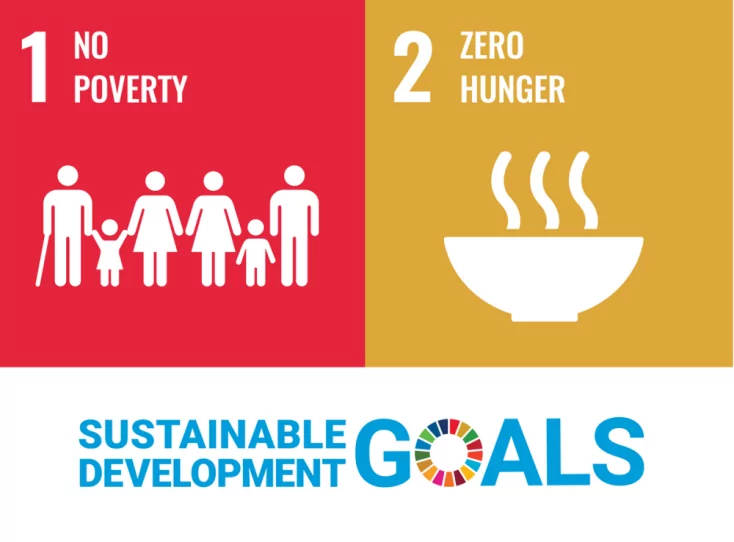What is the role of media in driving the SDGs 1: No Poverty and SDG 2: Zero Hunger? Below is an excerpt from our brief “The role of media: Driving change towards the SDGs”, published to mark the Global Week to #Act4SDGs.
“…in the terrible history of famines in the world, no substantial famine has ever occurred in any independent and democratic country with a relatively free press”
– Amartya Sen, Nobel Prize laureate in Economics[i]
A free press is associated with lower poverty levels[ii] and plays a critical role in poverty reduction[iii]. Through its watchdog function, the media ensures protection for vulnerable citizens by making governments more accountable and responsive[iv]. For example, it has been shown that the higher the penetration of radio, the more relief funds were allocated by governors in a given area[v]. A healthy media sector enables inclusive public debate on issues of concern to the poor and ensures they have access to relevant information that helps them make informed choices and empowers them to take an active role in public life[vi].
Additionally, the work of independent media is associated with reduced malnutrition and famine[vii]. In fact, researchers found that regional administrations with higher levels of newspaper circulation were more active in responding to emergency food shortages[viii]. Journalists and their work also play a key role in providing meaningful and timely information to both farmers and the public, promoting climate-smart agricultural practices and covering a range of issues, from food security and distribution to weather patterns, floods and droughts[ix].
Below we present case studies of impactful journalism and information-sharing by MDIF clients in the area of SDGs 1 and 2 as real-world examples that illustrate the transformative power of media.
Examples of impact
In India, digital company Gram Vaani documented the stories of vulnerable groups who faced challenges in accessing Covid-relief. Its #NotStatusQuo campaign captured many such issues via 7,000 voice reports submitted through its Mobile Vaani voice-based community platform and prompted wider action. For example, in Tamil Nadu, Gram Vaani was engaged in an active campaign to resume free meals for children in the “Midday Meal” scheme. After disruptions in child health and nutrition services were reported through Mobile Vaani, many of the affected children started receiving their rations again. “I recorded the issue related to non-availability of midday meals on Mobile Vaani and after 3-4 days, the ration got distributed to all children of my village,” one testimony read.
Online Indian outlet Scroll exposed how the state government of Jharkhand failed to provide a monthly welfare scheme to 1 million impoverished senior citizens, widows and people with disabilities for at least five months in the middle of the pandemic, leading to hunger, debt and distress. The reason, according to state government officials, was the lack of money in Jharkhand’s coffers due to the central government’s delays in transferring funds to the state. A week after Scroll published the report, the National Human Rights Commission issued a notice to the government of Jharkhand and the Union Ministry of Social Justice and Empowerment, giving them six weeks to submit a detailed report on the delays.
Read the full brief “The role of media: Driving change towards the SDGs” here.
[i] Sen, A (1999). “Democracy as a Universal Value” Journal of Democracy”. Routledge.
[ii] Guseva, M et al. (2008). “Press freedom and development: an analysis of correlations between freedom of the press and the different dimensions of development, poverty, governance and peace”. United Nations Educational Scientific and Cultural Organization.
[iii] Deane, D (2008). “Why the Media Matters: the Relevance of the Media to Tackling Global Poverty”.
[iv] Huma Haider, et al. (2011). “Topic Guide on communication and governance”.
[v] Strömberg, D (2004). “Radio’s impact on public spending”. The Quarterly Journal of Economics.
[vi] Callamard, A (2006). “Development, poverty and freedom of expression”. UNESCO Conference on Freedom of the Media and Development.
[vii] Guseva, M et al. (2008). “Press freedom and development: an analysis of correlations between freedom of the press and the different dimensions of development, poverty, governance and peace”. United Nations Educational Scientific and Cultural Organization.
[viii] Besley, T. Burgess, R (2002). “The Political Economy of Government Responsiveness: Theory and Evidence from India”. The Quarterly Journal of Economics.
[ix] Khan, A (2021). “Food security and media development”. Trends in Food Science & Technology.
